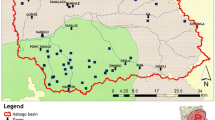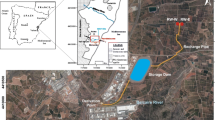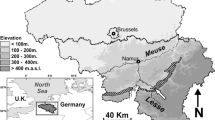Abstract
Managed aquifer recharge (MAR) is an efficient way to remove organic matter from raw water and, at the same time, reduce temperature variation. Two MAR sites were constructed by Karlskrona municipality on Johannishus Esker in Sweden. One of these sites, Vång, was monitored for electrical conductivity and electrical resistivity (using electrical resistivity tomography - ERT) during a 9-week tracer infiltration test. The aim of the monitoring was to map the pathways of the infiltrated water, with the overall goal to increase the efficiency of the MAR. ERT proved useful in determining both the nature of the esker formation and the water migration pathways. In Vång, the esker ridge follows a tectonically controlled paleo-valley. The fault/fracture zone in the bedrock along this paleo-valley was mapped. During the tracer test, the infiltrated water was detected in the area close to the infiltration ponds, whereas far-situated observation wells were less affected. For sequential infiltration and recharge periods in MAR, the timing of the well pumping is another important factor. Natural groundwater flow direction was a determinant in the infiltration process, as expected. ERT measurements provide supplementary data for site selection, for monitoring the functionality of the MAR sites, and for revealing the geological, hydrogeological and structural characteristics of the site.
Résumé
La recharge contrôlée d’aquifère (MAR) est un moyen efficace pour éliminer la matière organique de l’eau brute, et en même temps de réduire les variations de température. Deux sites MAR ont été construits par la municipalité de Karlskrona sur l’Esker de Johannishus en Suède. Un de ces sites, Vång, a été contrôlé pour la conductivité électrique et la résistivité électrique (en utilisant la tomographie de résistivité électrique – ERT) lors d’un essai d’infiltration avec traceurs d’une durée de neuf semaines. Le but de la surveillance était de cartographier les cheminements de l’eau infiltrée, avec un objectif général d’accroître l’efficacité de la recharge contrôlée de l’aquifère. L’ERT s’est avérée utile pour déterminer à la fois la nature de la formation de l’esker et les cheminements de l’eau infiltrée. A Vång, la crête de l’esker suit une paléo-vallée contrôlée par la tectonique. La zone de faille/fracture dans le sous bassement rocheux le long de cette paléo-vallée a été cartographiée. Au cours de l’essai de traçage, l’eau infiltrée a été détectée dans la zone proche des bassins d’infiltration, alors que les piézomètres d’observation éloignés ont été moins impactés. Pour les périodes d’infiltration séquentielle et de recharge, la période de pompage au puits est un autre facteur important. La direction d’écoulement naturel des eaux souterraines a été un facteur déterminant dans le processus d’infiltration, comme prévu. Les mesures d’ERT fournissent des données supplémentaires pour la sélection du site, pour le suivi de la fonctionnalité des sites de MAR, et pour révéler les caractéristiques géologiques, hydrogéologiques et structurales du site.
Resumen
El manejo de la recarga de un acuífero (MAR) es una forma eficiente para remover materia orgánica del agua cruda y, al mismo tiempo, reducir la variación de la temperatura. Dos sitios MAR fueron construidos por la Municipalidad de Karlskrona en Johannishus Esker en Suecia. Uno de estos sitios, Vång, fue monitoreado en relación a la conductividad eléctrica y resistividad eléctrica (usando la tomografía de resistividad eléctrica - ERT) durante las nueve semanas una prueba de infiltración por trazadores. El objetivo del monitoreo fue mapear las trayectorias del agua infiltrada, con la meta general de aumentar la eficiencia del MAR. La ERT probó ser útil para determinar tanto la naturaleza de la formación del esker como las vías de migración de agua. En Vång, la cresta del esker sigue un paleovalle tectónicamente controlado. Se mapeó la zona de falla / fractura en la roca de base a lo largo de este paleovalle. Durante la prueba de trazadores, el agua infiltrada se detectó en el área cercana a las lagunas de infiltración, mientras que los pozos de observación situados lejos fueron menos afectados. El ritmo de bombeo del pozo es otro factor importante para la infiltración secuencial y los períodos de recarga en el MAR, La dirección natural del flujo de agua subterránea fue un factor determinante en los proceso de infiltración, tal como se esperaba. Las medidas de ERT proporcionaron datos suplementarios para la selección del sitio, para monitorear la funcionalidad de los sitios MAR, y para revelar las características geológicas, hidrogeológicas y estructurales del sitio.
抽象
摘要:管理的含水层补给(MAR)是从原水中除去有机物、同时也是减少温度变化的有效途径。瑞典Karlskrona市政府在Johannishus蛇形丘建设了两个管理的含水层补给场地。其中之一Vång场地在9周的示踪剂入渗试验期间用来监测电导率和电阻率(采用电阻率断层摄影术)。监测的目的就是绘制入渗水的路径,总的目标就是增强管理的含水层补给的效率。电阻率断层摄影术在确定蛇形丘地层的特性和水运移路径方面证明非常有用。在Vång场地,蛇形丘的边缘沿构造控制的古山谷分布。测绘了沿这个古山谷分布的基岩中的断层/断裂带。在示踪剂实验期间,入渗池附近的区域检测到了入渗水,而远处的观测井受到的影响就很小。对于管理的含水层补给中的连续入渗和补给期,水井抽水计时是另一个重要因素。天然地下水流方向正如所预料的那样是入渗过程中的决定因素。电阻率断层摄影术测量结果为场地选择提供了补充资料,以监测管理的含水层补给场地的功能及揭示场地的地质、水文地质和构造特征。
Resumo
A recarga controlada de aquíferos (RCA) é um método eficiente para remover a matéria orgânica da água não tratada e, ao mesmo tempo, reduzir a variação de temperatura. Foram construídos dois sítios para RCA no município de Johannishus Esker, na Suécia. Um destes sítios, Vång, foi monitorizado para condutividade elétrica e resistividade elétrica (usando tomografia de resistividade elétrica – TRE) durante um ensaio de traçadores de nove semanas. O objetivo da monitorização foi o mapeamento das linhas de fluxo da água infiltrada, com o objetivo global de aumentar a eficiência da RCA. A TRE revelou-se útil na determinação da natureza da formação de esker e na definição das linhas de migração da água. No Vång, a crista do esker segue um paleo-vale com controlo tectónico. A zona de falha/fratura do substrato rochoso ao longo deste paleo-vale foi mapeada. Durante o ensaio de traçadores, a água infiltrada foi detetada na área próxima dos tanques de infiltração, enquanto poços localizados mais longe foram menos afetados. Para a infiltração sequencial e os períodos de recarga na RCA, a duração da extração nos poços é outro fator importante. A direção do fluxo subterrâneo natural foi determinante no processo de infiltração, tal como esperado. As medições de TRE proporcionam dados suplementares para a seleção do local, a monitorização do funcionamento dos locais da RCA e para revelar as caraterísticas geológicas, hidrogeológicas e estruturais do sítio.
Öz
Yapay besleme yönetimi (YBY) ham suyu organik maddeden temizlemek ve aynı zamanda sıcaklık değişimlerini düşürmek için etkili bir yoldur. İsveç’te Johannishus Eskeri üzerinde Karlskrona yerel idaresi tarafından iki YBY alanı kurulmuştur. Bu alanlardan bir tanesi, Vång, dokuz haftalık bir izleyici süzülme deneyi süresince elektrik iletkenlik ve elektrik rezistivite yöntemleriyle (elektrik rezistivite tomografisi -ERT- kullanılarak) izlenmiştir. Bu gözlemin amacı süzülen suyun haritalanması ve ana amacı da YBY’nin etkinliğinin artırılmasıdır. ERT’nin hem esker oluşumunun doğasının anlaşılması hem de suyun göç yollarının belirlenmesi için faydalı olduğu görülmüştür. Vång’da, esker sırtı tektonik kontrollü bir paleo-vadiyi takip etmektedir. Ana kayaç içinde, bu paleo-vadi boyunca devam eden fay/kırık hattı haritalanmıştır. İzleme deneyi süresince, besleme havuzlarına yakın alanlarda süzülme gözlenmiş, buna karşın uzakta yer alan gözlem kuyuları daha az etkilenmiştir. YBY’lerde seri besleme ve geri-besleme süreçleri için, pompalamanın zamanlaması da önemli diğer bir faktördür. Bekleneceği üzere süzülme süreci boyunca doğal yeraltısuyu akış yönü belirleyicidir. YBY alanlarının işlevselliğinin gözlenmesi, alan seçimi ve sahanın jeolojik, hidrojeolojik ve yapısal özelliklerinin ortaya çıkarılması için ERT ölçümleri bütünleyici veri sağlamaktadır.










Similar content being viewed by others
References
Artimo A, Mäkinen J, Berg RC, Abert CC, Salonen V-P (2003) Three-dimensional geologic modeling and visualization of the Virttaankangas aquifer, southwestern Finland. Hydrogeol J 11:378–386
Banerjee I, McDonald BC (1975) Nature of esker sedimentation. Glaciofluvial Glaciolacustrine Sedimentol 23:132–154
Barker RD, Moore J (1998) The application of time-lapse electrical tomography in groundwater studies. Lead Edge 17:1454–1458
Berglund BE, Sandgren P, Barnekow L, Hannon G, Jiang H, Skog G, Yu S-Y (2005) Early Holocene history of the Baltic Sea, as reflected in coastal sediments in Blekinge, southeastern Sweden. Quat Int 130:111–139
Bolduc A, Paradis SJ, Riverin M-N, Lefebvre R, Michaud Y (2006) A 3D Esker geomodel for groundwater research: the case of the Saint-Mathieu-Berry esker, Abitibi, Québec, Canada. In: Russell HAJ, Berg RC, Thorleifson HL (eds) 3D geologic mapping for groundwater applications: workshop extended abstracts. Geol Surv of Can Open File 5048
Boulton GS, Hagdorn M, Maillot PB, Zatsepin S (2009) Drainage beneath ice sheets: groundwater–channel coupling, and the origin of esker systems from former ice sheets. Quat Sci Rev 28:621–638
Brennand TA (2000) Deglacial meltwater drainage and glaciodynamics: inference from Laurentide eskers, Canada. Geomorphol 32:263–293
Burke MJ, Woodward J, Russell AJ, Fleisher PJ (2009) Structural controls on englacial esker sedimentation: Skeiðarárjökull, Iceland. Ann Glaciol 50(51):85–92
Campbell JE (2003) Quaternary investigations in the Patterson Island area (part of NTS 64E-10 and -15), Reindeer Lake, Eastern Peter Lake Domain. In: Summary of Investigations 2003, vol 2. Misc. Rep. 2003–4.2, Paper A-7, Saskatchewan Geological Survey, Sask. Industry Resources, Regina, SK, 16 pp
Cassiani G, Bruno V, Villa A, Fusi N, Binley AM (2006) A saline trace test monitored via time-lapse surface electrical resistivity tomography. J Appl Geophys 59(3):244–259
Claerbout JF, Muir F (1973) Robust modeling with erratic data. Geophys 38:826–844
Corriols M, Dahlin T (2008) Geophysical characterization of the León-Chinandega aquifer, Nicaragua. Hydrogeol J 16:349–362
Dahlin T (1996) 2D resistivity surveying for environmental and engineering applications. First Break 14(7):275–283
Dahlin T (2001) The development of DC resistivity imaging techniques. Comput Geosci 27:1019–1029
de Geer J (1968) Some hydrogeological aspects on aquifers, especially eskers. In: Eriksson E, Gustafsson Y, Nilsson K (eds) Groundwater problems. Pergamon, New York
Flint RF (1971) Glacial and Quaternary geology. Wiley, New York
Frycklund C (1998) Long-term sustainability in artificial groundwater recharge. In: Peters JH et al (eds) Artificial recharge of groundwater. Balkema, Rotterdam
Frycklund C, Jacks G (1997) Iron and artificial recharge of groundwater. Boreal Environ Res 2:171–81
Greskowiak J, Prommer H, Massmann G, Johnston CD, Nützmann G, Pekdeger A (2005) The impact of variably saturated conditions on hydrogeochemical changes during artificial recharge of groundwater. Appl Geochem 20:1409–1426
Hägg M, Bergman B, Lindberg J, Hebrand M (2010) Karlskrona Kommun, Karlskrona vatten: fullskaleförsök med saltinfiltration och geofysiska mätningar [Karlskrona municipality, Karlskrona water: full scale tests with salt infiltration and geophysical surveys]. SWECO VBB VIAK 1240121000, Sweco, Malmö, Sweden, 56 pp
Härme M (1961) On the fault lines in Finland. Bull Comm Geol Finlande 196:437–444
Hebrand M (2001) Karlskrona municipality, Karlskrona water: technical description of water activity at Johannishus ridge (in Swedish). VBB VIAK 1240121, Malmö, Sweden, 48 pp
Hebrand M, Åmark M (1989) Esker formation and glacier dynamics in eastern Skåne and adjacent areas, southern Sweden. Boreas 18:67–81
Hebrand M, Björkman F (2005) Karlskrona vattenförsörjning: undersökning av infiltrationsområden vid Johannishusåsen [Karlskrona water supply: investigation of infiltration areas at Johannishus Ridge]. SWECO VIAK 1240121, Sweco, Malmö, Sweden, 59 pp
Hebrand M, Jeppson H (1999) Karlskrona municipality, Karlskrona water: hydrogeological investigations at Johannishus Ridge 1997–1999 (in Swedish). SWECO VBB VIAK 1240121, Malmö, Sweco, Sweden, 130 pp
Helmisaari H-S, Kitunen V, Lindroos A-J, Lumme I, Monni S, Nöjd P, Paavolainen L, Pesonen E, Salemaa M, Smolander A, Derome J (1998) Sprinkling infiltration in Finland: effects on forest soil, percolation water and vegetation. In: Peters JH et al (eds) Artificial recharge of groundwater. Balkema, Rotterdam
Hyyppä E (1954) Äsarnas uppkomst [Genesis of ridges]. Geolog 6:45
Katko TS, Lipponen MA, Rönkä EKT (2006) Groundwater use and policy in community water supply in Finland. Hydrogeol J 14:69–78
LaBrecque D, Daily W (2008) Assessment of measurement errors for galvanic-resistivity electrodes of different composition. Geophysics 73(2):F55–F64
Liang L, McCarthy JF, Jolley LW, McNabb JA, Mehlhorn TL (1993) Iron dynamics: transformation of Fe(II)/Fe(III) during injection of natural organic matter in a sandy aquifer. Geochim Cosmochim Acta 57:1987–1999
Lindroos A-J, Derome J, Niska K (1995) The relationship between dissolved organic matter and percolation water chemistry in northern Finland. Water Air Soil Pollut 79:191–200
Lindroos A-J, Kitunen V, Derome J, Helmisaari H-S (2002) Changes in dissolved organic carbon during artificial recharge of groundwater in a forested esker in southern Finland. Water Res 36:4951–4958
Loke MH (1999) Time-lapse resistivity imaging inversion. Proceedings of the 5th Meeting of the Environmental and Engineering Geophysical Society European Section, Em 1, Budapest, September 1999
Loke MH, Barker RD (1996) Rapid least squares inversion of apparent resistivity pseudosections by a quasi-Newton method. Geophys Prospect 44:131–152
Loke MH, Acworth I, Dahlin T (2003) A comparison of smooth and blocky inversion methods in 2-D electrical imaging surveys. Explor Geophys 34(3):182–187
Lundqvist J, Wohlfarth B (2001) Timing and east–west correlation of south Swedish ice marginal lines during the Late Weichselian. Quat Sci Rev 20:1127–1148
Lundström US (1993) The role of organic acids in the soil solution chemistry of a podzolized soil. J Soil Sci 44:121–133
Mäkinen J (2003) Time-transgressive deposits of repeated depositional sequences within interlobate glaciofluvial (esker) sediments in Köyliö, SW Finland. Sedimentology 50:327–360
Malmberg Persson K, Persson M (2009) Beskrivning till jordartskartan 3 F Karlskrona NV & SV [Description of soil map 3 F Karlskrona NW & SW]. Sveriges Geologiska Undersökning K 155, SGU, Uppsala, Sweden, 11 pp
Mendoza JA, Dahlin T, Barmen G (2006) Hydrogeological and hydrochemical features of an area polluted by heavy metals in central Nicaragua. Hydrogeol J 14:1052–1059
Morris M, Rønning JS, Lile OB (1996) Geoelectric monitoring of a tracer injection experiment: modeling and interpretation. Eur J Environ Eng Geophys 1:15–34
Neuendorf KKE, Mehl JP Jr, Jackson JA (2005) Glossary of Geology, 5th edn. American Geological Institute, Alexandria, VA
Nilsson SI, Bergkvist B (1983) Aluminium chemistry and acidification processes in a shallow podzol on the Swedish west coast. Water Air Soil Pollut 20:311–330
Nöjd P, Lindroos A-J, Smolander A, Derome J, Lumme I, Helmisaari H-S (2009) Artificial recharge of groundwater through sprinkling infiltration: impacts on forest soil and the nutrient status and growth of Scots pine. Sci Total Environ 407:3365–3371
Okkonen J, Jyrkama M, Kløve B (2010) A conceptual approach for assessing the impact of climate change on groundwater and related surface waters in cold regions (Finland). Hydrogeol J 18:429–439
Parsons ML (1970) Groundwater movement in a glacial complex, Cochrane district, Ontario. Can J Earth Sci 7(3):869–883
Persson K (2008) Karlskrona vattenförsörjning, Utvärdering av spårämnesförsök i Johannishusåsen, etapp Västra Vång [Evaluation of tracer tests in Johannishus Ridge, West Vång stage]. SWECO 1240121000, Sweco, Malmö, Sweden, 8 pp
Ringberg B (1969) Inventory of gravel deposits in the county. County Administrative Board of Blekinge, Karlskrona, Sweden, 314 pp
Ringberg B (1976) Glacialgeologi och isavsmältning i östra Blekinge [Glacial geology and deglaciation in the eastern Blekinge]. SGU C661, Swedish Geological Survey, Uppsala, Sweden, 174 pp
Russell AJ, Knudsen O, Fay H, Marren PM, Heinz J, Tronicke J (2001) Morphology and sedimentology of a giant supraglacial, ice-walled, jökulhlaup channel, Skeidarárjökull, Iceland: implications for esker genesis. Glob Planet Chang 28:193–216
SGU (2012) Digital geological and geophysical maps. Geol. Surv. of Sweden, Uppsala, Sweden
Shreve RL (1985) Esker characteristics in terms of glacier physics, Katahdin esker system, Maine. Geol Soc Am Bull 96:639–646
Singha K, Gorelick SM (2005) Saline tracer visualized with three-dimensional electrical resistivity tomography: field-scale spatial moment analysis. Water Resour Res 41(W05023):17
Syverson KM, Gaffield SJ, Mickelson DM (1994) Comparison of esker morphology and sedimentology with former ice-surface topography, Burroughs Glacier, Alaska. Geol Soc Am Bull 106:1130–1142
Thurman EM (1985) Humic substances in groundwater. In: Aiken GR, McKnight DM, Wershaw RL, MacCarthy P (eds) Humic substances in soil, sediment and water. Wiley, New York
Warren WP, Ashley GM (1994) Origins of the ice-contact stratified ridges (eskers) of Ireland. J Sediment Res A64:433–449
White PA (1988) Measurement of ground-water parameters using salt-water injection and surface resistivity. Groundwater 26:179–186
White PA (1994) Electrode arrays for measuring groundwater flow direction and velocity. Geophys 59:192–201
Yu S-Y (2003) The Littorina transgression in southeastern Sweden and its relation to mid-Holocene climate variability. PhD Thesis, Lundqua Thesis 51, Lund University, Sweden, 28 pp
Acknowledgements
This work was funded by Karlskrona Municipality, Sweden, whom we thank for permission to publish the results. The field test and evaluation of the results, from a design and production point of view, was carried out by Sweco VIAK, Malmö, Sweden. İnan Ulusoy was guest reseacher at Lund University thanks to a grant from the Swedish Institute, which is gratefully acknowledged. The authors are grateful to P. Comida for supporting the field activity. We are very grateful to Dr. Alfredo Mendoza and Dr. Mats Hebrand for their astute comments and constructive remarks on the earlier draft of the manuscript, and Jan Lindberg for help with documentation from the field test. We are thankful to Dr. Richard Owen for his constructive remarks and for improving the English of the manuscript. Furthermore, we wish to thank Jacopo Boaga and two anonymous reviewers for constructive criticism on the manuscript.
Author information
Authors and Affiliations
Corresponding author
Rights and permissions
About this article
Cite this article
Ulusoy, İ., Dahlin, T. & Bergman, B. Time-lapse electrical resistivity tomography of a water infiltration test on Johannishus Esker, Sweden. Hydrogeol J 23, 551–566 (2015). https://doi.org/10.1007/s10040-014-1221-2
Received:
Accepted:
Published:
Issue Date:
DOI: https://doi.org/10.1007/s10040-014-1221-2




